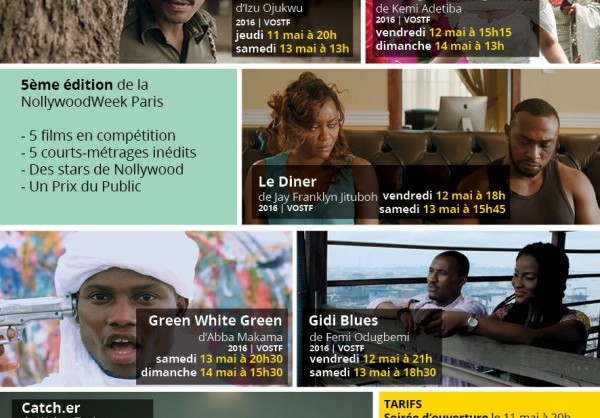Showbiz
Nigeria’s Showbiz/Media Sector Will Generate $9.9b Revenue by 2022—PwC

By Modupe Gbadeyanka
A new report by PwC has disclosed that the entertainment and media (E&M) industry in Nigeria will generate a revenue of $9.9 billion by 2022 from the $3.8 billion raked in 2017.
In its ‘Entertainment and Media Outlook: 2018 – 2022: An African Perspective’ released today and obtained by Business Post, PwC said last year, Nigeria saw a huge 25.5 percent rise in E&M revenue, although $605 million of this $764 million rise was attributable to Internet access.
“A 21.5 percent CAGR rate is anticipated to 2022, with revenue reaching $9.9 billion in that year. Again, Internet access revenue will account for 89.6 percent of this absolute growth,” the report said.
PwC noted that in report that Africa’s entertainment and media industry has entered a dynamic new phase, a third wave of convergence.
It said the borders that once separated E&M, technology and telecommunications industries are blurring in the battle for the attention of the consumer in a world that is rapidly digitising.
As the mobile device cements itself as the pre-eminent source of the E&M experience, the most disruptive, forward-thinking companies are striving to create an integrated ecosystem suited to this consumer-driven dynamic, it said further.
According to PwC, by 2022, total E&M revenue in South Africa is expected to reach R177.2 billion, up from R129.2 billion in 2017. Internet (access and advertising) is expected to grow at a compound annual growth rate (CAGR) of 11.3 percent over the forecast period to reach R91.2 billion, up from R53.4 billion in 2017.
Overall E&M growth will be less reliant on Internet access revenue as organic growth opportunities in Internet connections start fading towards the end of the forecast period. Internet advertising will greatly exceed TV advertising in terms of growth, leading the way with a 13 percent CAGR over the forecast period to reach R9.4 billion and overtake TV advertising spend in 2022.
The Outlook is a comprehensive source of analyses and five-year forecasts of consumer and advertising spending across five countries (South Africa, Nigeria, Kenya, Ghana and Tanzania) and 14 segments: Internet, data consumption, television, cinema, video games, e-sports, virtual reality, newspaper publishing, magazine publishing, book publishing, business-to-business (b2b), music, out-of-home (OOH) and radio.
Vicki Myburgh, Entertainment and Media Leader for PwC Southern Africa, says: “It’s clear we’re in a rapidly evolving media ecosystem that’s experiencing Convergence 3.0. In Convergence 3.0, the dynamics of competition are evolving while a cohort of ever-expanding super competitors and more focussed players strive to build relevance at the right scale. And business models are being reinvented so all players can tap into new revenue streams, by, for example, targeting fans and connecting more effectively with customers to develop a membership mind-set.
“The pace of change isn’t going to let up anytime soon. New and emerging technologies such as artificial intelligence and augmented reality will continue to redefine the battleground. In an era when faith in many industries is at a historically low ebb and regulators are targeting media businesses’ use of data, the ability to build and sustain consumer trust is becoming a vital differentiator.”
South Africa’s E&M industry faced a challenging year in 2017 amidst economic and socio-political uncertainty. Total E&M revenue rose at a comparatively low rate of 6.8% year-on-year to R129.2 billion. A bounce-back in 2018 sees an anticipated 7.6% year-on-year growth, while the CAGR to 2022 is forecast at 6.5 percent.
South Africa will see a strong CAGR of 7.6 percent for consumer revenue to 2022, moving from R93.9 billion in 2017 to R135.7 billion in 2022. Beyond revenue from the Internet segment (buoyed by apps revenue) there are many success stories, most notably that of video games, which will surpass books, magazines and B2B to become the third-highest contributing consumer segment.
There is a striking difference in growth between digital and non-digital revenue, which have CAGRs of 11.4 percent and 1.8 percent respectively. Put another way, digital revenue will add R41.3 billion and non-digital revenue R6.7 billion in absolute terms to 2022. The non-digital elements of five different segments – books, magazines, newspapers, OOH and video games – will all decline to 2022.
Within this overall increase, the fastest revenue growth will be in the digitally driven segments. Virtual reality will lead the way, albeit from a low base, at a five-year CAGR of 55 percent to reach R671 billion in 2022, from R75 billion in 2017.
“The exceptional growth in VR reflects the excitement in this space. VR devices and experiences are in the early stages of being accepted by the mainstream, as VR now emerges as a viable long-term platform for unique, immersive experiences, attracting major investment from media and technology companies eager to seize a share of this fast-growing market,” Myburgh adds.
After a breakthrough year, South Africa’s total e-sports revenue is forecast to rise from R29 million in 2017 to R104 million in 2022, a CAGR of 29 percent. A host of high profile events in 2017 helped to propel e-sport further towards the mainstream, and a number of similar events have been and are being held this year.
A booming social/casual sector is driving strong growth in the video games segment. Total revenue is forecast to rise from R3.1 billion in 2017 to R6.2 billion in 2022, a CAGR of 15 percent. TV and video will continue to be a major driver of consumer spend. Following growth at 4.8 percent CAGR over the forecast period, the total TV market will be worth R40.8 billion by 2022.
The shift from physical to digital media has been one of the core drivers of the global and local E&M market for many years. But different media segments have experienced strongly contrasting patterns of digitisation. In some cases, consumers have been quick to drop physical formats and embrace digital alternatives at the first opportunity.
Although the growth rate for physical books is moderate, it is notable that books are performing far better than any other non-digital sector.
“Permanency and collectability may be the reason for this. Books are seen as collectibles often owned and displayed for many years, making the loss of their physical presence more significant,” explains Myburgh. Although books currently seem to have the best prospects of any physical media format, they are, like every other media segment, just one disruptive digital competitor away from major upheaval.
Newspapers and magazines will see revenues decline over the next five years. In 2017, total newspaper revenue fell by – 2.9 percent to R8.6 billion. The forecast for the years ahead is for decline at -4 percent CAGR. By 2022, South African total newspaper revenue is expected to drop to R7 billion.
Despite 24/7 access to media and entertainment, the appeal of shared, live experiences still attracts audiences. Music events still draw large crowds, with ticket sales set to see an 8.0 percent CAGR to 2022, helped by major tours from popular crowd-pulling acts in 2018.
Recovering admissions and rising ticket prices together with improved offerings will see box office revenue deliver modest growth at a 3.5 percent CAGR through 2022. South African audiences are prepared to pay a premium to watch big-budget films with surround sound, vibrating seats, temperature change, strobe lights and so on. Radio continues to have a solid listener base in South Africa, and a weekly reach of 91 percent. Radio revenue is projected to rise 3.9 percent CAGR over the forecast period to surpass the R5 billion mark in 2022.
Chat apps and social platforms have become an increasingly important part of day-to-day life for consumers, both in South Africa and worldwide. As usage and entertainment rise, key players from across the E&M industry have teamed up with these platforms, growing them into ‘one-stop shops’ for consumer needs.
The report shows that advertising in the E&M industry was mostly affected by South Africa’s economic environment, with cautious growth of just 1.9 percent year on year. An improvement is expected to 2022, with a 3.3 percent CAGR bringing total advertising revenue to R41.5 billion, from R35.3 billion in 2017. New technologies and devices like artificial intelligence (AI), virtual and augmented reality, voice-based smart home devices and virtual assistants look set to drive innovation in online advertising on a global scale in the coming years.
The report also said Kenya’s E&M industry saw 17 percent year-on-year growth in 2017, again propelled by growth in the Internet sector. An 11.6 percent CAGR will take the country to $2.9 billion in 2022, from $1.7 billion in 2017. Outside of the Internet space, TV and video revenue dwarfs the other segments.
In addition, Ghana’s E&M industry has more than tripled in value since 2013. Total revenue reached $752 million in 2017. It is forecast to surpass $1 billion in 2019 and to total $1.5 billion in 2022, increasing at a 14.2 percent CAGR. As with Nigeria and Kenya, Internet access spend accounts for much of this revenue and growth. Ghana is in a strong position for further E&M growth as revenue gains critical mass over the next five years.
It further said total E&M revenue in Tanzania stood at $496 million in 2017, having risen 28.2 percent year on year. Continued momentum at an 18.3 percent CAGR will see revenue reach $1.2 billion in 2022, 2.3 times the size of the market in 2017. Tanzania’s E&M revenue make-up is ostensibly similar to that of Ghana, although here Internet revenue takes a slightly less dominant position.
Between them, the five countries considered in the Outlook will, driven by Nigeria, add $12.4 billion in revenue from 2017 to 2022, at a combined CAGR of 11.9 percent. Although much of this will fall into the hands of telcos, there are significant opportunities for content providers too. The engine of growth here will be organic, with increased populations and gradually increasing disposable income swelling the ranks of potential E&M consumers – and ever-increasing Internet access greatly expanding the range of E&M opportunities available.
“To succeed in the future that’s taking shape, companies must re-envision every aspect of what they do and how they do it. It’s about having, or having access to, the right technology and excellent content, which is delivered in a cost-effective manner to an engaged audience that trusts the brand. For those able to execute successfully, the opportunities are legion,” Myburgh concludes.
Showbiz
MTF’s Best Graduating Student Winner Achimugu Begins New York Film Academy NYFA Journey

Winner Achimugu, the MultiChoice Talent Factory (MTF) Best Graduating Student 2024, has embarked on a six-week scholarship at the prestigious New York Film Academy (NYFA). This achievement not only celebrates her exceptional talent and dedication but also reinforces MTF’s commitment to nurturing world-class African filmmakers ready to make their mark on the global stage.
Since its inception, MTF has been more than just a training ground; it’s a launchpad for African storytellers. Alumni from the academy have consistently demonstrated excellence, with films and projects winning awards, receiving grants, and gaining international recognition. Notable projects include 2070, which clinched Best Short Film at the African SDGs Film Festival, and Isekonu, a Zee World short film, officially selected for the Lagos Fringe Festival 2025 and nominated for Best Student Film at the Bayelsa International Film Festival.
These achievements reflect MTF’s ethos of equipping young filmmakers with both the technical skills and creative vision necessary to succeed, both locally and internationally.
The 2024 Best Graduating Student, Winner Achimugu, distinguished herself among her peers with a combination of talent, dedication, and storytelling finesse. Her selection for the NYFA scholarship is a testament to her hard work and to the quality of mentorship and training at MTF.
Through this program, she will engage in intensive workshops, hands-on training, and industry exposure that promise to elevate her craft. The scholarship is not just an award, it is a bridge connecting African storytelling to global cinematic opportunities, embodying MTF’s brand promise of fostering talent that transcends borders.
This scholarship opens new avenues for growth, offering exposure to international techniques, networks, and collaborative experiences that could define the trajectory of her career. For MTF, it’s a validation of its mission: cultivating a generation of filmmakers whose creativity, vision, and impact will resonate far beyond Africa.
As this journey unfolds, it reinforces the message that African cinema is on the rise, powered by storytellers who are ready to take their place on the world stage. With MTF alumni leading the way, the future of African filmmaking looks brighter than ever.
Showbiz
Quickteller Celebrates African Creativity in Lagos With InsomniaQ

By Modupe Gbadeyanka
A 12-hour non-stop entertainment event offering various performances and activities all night long will take place in Lagos from the evening of December 21 into the early hours of December 22, 2025.
This programme known as InsomniaQ, is being put together by one of Africa’s leading digital payments platforms, Quickteller.
Quickteller is a brand powered by the Interswitch Group, and InsomniaQ was created to celebrate African creativity.
The all-night music and entertainment experience will hold at the Ballroom of the Lagos Continental Hotel, Victoria Island.
It is designed to capture the vibrancy and cultural energy that define Lagos in December. InsomniaQ is positioned to become Africa’s newest must-attend December destination.
The concert blends diverse African soundscapes, creative expression, and immersive lifestyle experiences, offering a night curated for music lovers, diaspora returnees, cultural enthusiasts, and everyone drawn to the city’s festive season.
More than a concert, InsomniaQ represents a new cultural moment, one that celebrates the richness, depth, and diversity of African talent. With a lineup cutting across contemporary and alternative genres, the festival aims to introduce a bold, fresh, and unforgettable experience within Lagos’ already vibrant entertainment landscape.
“InsomniaQ is an invitation to celebrate African creativity in a way that feels bold, fresh, and true to who we are.
“Quickteller has always been an essential part of the experiences people value, and this festival brings that connection to life in an entirely new dimension.
“As Lagos welcomes friends, family, and visitors from around the world each December, we are proud to introduce a platform that showcases our music, our culture, and the vibrant energy that defines this season,” the Divisional Head of Growth Marketing for Quickteller Ecosystem at Interswitch, Mr Olawale Akanbi, noted.
Through Quickteller, Interswitch continues to champion initiatives that go beyond digital transactions to enrich the everyday life of millions of Nigerians.
InsomniaQ extends this mission by empowering cultural expression, unlocking creative opportunities, and supporting the continent’s growing entertainment ecosystem.
Showbiz
Oyindamola Timothy, Steve Adeyemo, Others Win Stanbic IBTC FUZE Talent Show 4.0

By Modupe Gbadeyanka
The quartet of Oyindamola Timothy (Fashion), Steve Adeyemo (Tech), Uche Kalu (Dance), and Emmanuel Elijah (Music) emerged the category winners of the Stanbic IBTC FUZE Talent Show 4.0.
They received N10 million each for their efforts, along with mentorship opportunities, industry exposure, and support to advance their creative journeys.
The four were chosen from the 12 finalists at an event aired on Sunday, December 14, 2025, on AIT (DStv Channel 253) at 7:00 pm, Africa Magic Showcase (DStv Channel 151) at 5:00 pm, and streamed live on the official Stanbic IBTC YouTube channel, connecting millions of viewers to the excitement and energy of the show.
The 2025 edition drew over 6,000 entries nationwide and continued to inspire a new wave of innovation among young Nigerians in fashion, technology, dance, and music. The participants fought for a share of the N90 million in prizes put up by the organisers.
This year, the FUZE Talent Show also introduced an exciting new twist: The Fan Favourite Feature, which allowed viewers across the country to vote for the contestant who most inspired them. This addition deepened audience participation and further strengthened FUZE’s mission to connect creativity with community support.
“FUZE 4.0 truly lived up to its promise as The Ultimate Show, a platform that celebrates courage, creativity, and innovation.
“Every contestant who graced that stage reminded us of the extraordinary potential of Nigerian youths.
“At Stanbic IBTC, we are proud to continue creating opportunities that help young people dream bigger, think bolder, and achieve more. It is all about home-grown talent for us as we power the made-in-Nigeria initiative,” the chief executive of Stanbic IBTC Holdings Plc, Mr Chuma Nwokocha, said.
As excitement builds for FUZE Festival coming up on Saturday, December 20, 2025, attendees can anticipate experiencing this year’s edition theme The Ultimate Show in full, with circus-style attractions, from magicians and parade performers to flash mobs and art displays.
An expanded marketplace, freebies from participating partners and on-site Stanbic IBTC services will enhance convenience, while performances by Wande Coal, Pheelz, Chike, and Ms DSF will add a nostalgic, high-energy finish. Interested attendees can register to attend via the Stanbic IBTC Events App or visit www.events.stanbicibtc.com to secure their spot.
-

 Feature/OPED6 years ago
Feature/OPED6 years agoDavos was Different this year
-
Travel/Tourism9 years ago
Lagos Seals Western Lodge Hotel In Ikorodu
-

 Showbiz3 years ago
Showbiz3 years agoEstranged Lover Releases Videos of Empress Njamah Bathing
-

 Banking7 years ago
Banking7 years agoSort Codes of GTBank Branches in Nigeria
-

 Economy3 years ago
Economy3 years agoSubsidy Removal: CNG at N130 Per Litre Cheaper Than Petrol—IPMAN
-

 Banking3 years ago
Banking3 years agoFirst Bank Announces Planned Downtime
-

 Banking3 years ago
Banking3 years agoSort Codes of UBA Branches in Nigeria
-

 Sports3 years ago
Sports3 years agoHighest Paid Nigerian Footballer – How Much Do Nigerian Footballers Earn















